Insightful AI time tracking for individuals and small teams—but too lightweight for managing field or deskless workers.
Verdict: 7.3/10
After using EARLY, I find it to be a thoughtfully designed tool that helps individuals and small teams understand how they spend their time. The interface is clean, the automation is smart, and the experience feels intuitive.
For freelancers, consultants, and focused remote teams, it’s a powerful productivity companion. Its AI suggestions and weekly reflections make time tracking feel effortless—not administrative.
However, when I tried to use it for broader team coordination, the gaps became clear. EARLY lacks essential tools for managing larger or deskless teams, like GPS tracking, geofencing, shift scheduling, in-app communication, training, and form-based workflows. It simply doesn’t support the operational or compliance needs of mobile or structured workforces.
If you want a personal or lightweight team tracker, EARLY delivers. But if you’re managing people, locations, and processes, you’ll need something more complex.
Key Features:
- Automatic time tracking: Let the system track your digital activity in the background and log time without manual input.
- Manual time entries: Add, edit, or delete time blocks directly when you want full control.
- Smart suggestions: Review the system’s recommendations (it recommends what you were likely working on) to create time entries quickly.
- Calendar view: Visualize your time allocation.
- Project & client tracking: Tag your time entries by project or client for clean organization and reports.
- Billable vs. non-billable tracking: Distinguish time that’s revenue-generating from internal or admin work.
- Absence & overtime tracking: Log time off, breaks, and extended work hours manually or through tracked patterns.
- Hardware tracker: Use the physical 8-sided tracker to switch tasks by flipping a side.
Pros
- Clean, intuitive interface
- Smart AI suggestions
- Multiple time tracking methods
- Reliable syncing across desktop, mobile, and calendar
Cons
- No GPS tracking or geofencing for field teams
- No shift scheduling, task assignment, chat, or file sharing features
- Higher pricing for teams despite fewer team controls
EARLY Pricing
EARLY offers 4 tiers: Personal, Personal Pro, Team, and a custom-priced Enterprise plan. Pricing is based on per-user monthly rates, with discounts for annual billing.
A 30-day free trial is available, and during onboarding, you’re asked to choose your team size (2–24, 25–50, 50+). I chose 2–24 users, which unlocked all premium features for testing. The hardware—which I couldn’t test—is an 8-sided tracker that comes at an additional 1-time cost of $69 (and there are volume discounts if you’re purchasing more than 10).
| Plan | Personal | Personal Pro | Team | Enterprise |
| No. of users | 1 | 1 | Up to 20 | 21+ |
| Billed monthly | $9.00/month | $14.00/month | $19.00/user/month | Custom |
| Billed annually | $7.50/month | $11.70/month | $15.80/user/month | Custom |
| Who it’s for | Solo users improving focus | Professionals billing clients | Small teams with shared tracking needs | Large orgs needing tailored solutions |
| Key features | Manual & auto time tracking, 1 project budget, productivity insights, API access | All Personal features + unlimited budgets, billable rates, calendar sync, data exports, Jira/Zapier integrations | All Pro features + shared dashboards, team analytics, permissions, reminders, success manager (20+ users) | All Team features + onboarding workshops, priority support, invoicing, procurement contracts, custom integrations |
For individuals, the Personal and Pro plans offer strong value, especially with automation, smart suggestions, and export-ready data. Teams of 5–25 can benefit from the Team plan, but the cost grows fast—$15.80/user/month, with no scheduling, task assignment, or GPS-based controls—features Connecteam offers alongside time tracking at a lower price point.
Larger organizations needing deeper integrations or procurement-ready plans can explore the Enterprise tier, which includes volume pricing and support services.
Compared with the time tracking software Clockify and Toggl Track, EARLY offers a more mindful, behavior-focused experience with AI time suggestions and weekly reflections. It feels built for improving habits, not just tracking hours. But both Clockify and Toggl offer free plans—and EARLY doesn’t.
To me, EARLY shines when you’re solo or in a tight-knit knowledge team. But if you’re trying to coordinate shifts, manage a mobile workforce, or automate operations, you’ll hit walls pretty fast—despite paying a premium.
| Team Size | EARLY (Team) | Toggl Track (Starter) | Time Doctor (Standard) | Connecteam (Basic) |
| View pricing | View pricing | View pricing | View pricing | |
| 10 Users | $158/month | $90/month | $117/month | Free for life — All features and dashboards |
| 20 Users | $316/month | $180/month | $234/month | $29 |
| 30 Users | $474/month | $270/month | $351/month | $29 |
| 50 Users | $790/month | $450/month | $585/month | $39 |
| Read our full Toggl Track review | Read our full Time Doctor review | Learn more about Connecteam | ||
| * All prices show the monthly cost per user when billed annually as of April 2025. | ||||
Verdict: 6/10
EARLY Usability & Interface

To use EARLY on desktop, you can download the desktop app or use the browser version. When you open the app, everything is organized into a clean, vertical layout with the main tabs clearly lined up. The tabs you see are Calendar, Insights, Budgets, Quicktrack, Notifications, Settings, and your Folders or Projects area. There’s no top bar—everything runs from that left-hand sidebar, which keeps the layout distraction-free and focused.
- Calendar tab: Main time-tracking hub. View by day or week, with side-by-side columns for manual entries, automatic tracking, and calendar events. Easily click, drag, resize, or edit time blocks.
- Insights tab: Visual breakdowns of time spent on tasks, projects, or clients. Includes pie charts and activity streaks to help analyze work patterns.
- Budgets tab: Set time limits on projects or clients. Get notified when you or your team are close to exceeding hours—great for managing billable or fixed-scope work.
- Notifications: Alerts for team activity, shared entries, or approvals (available for the Team and Enterprise plans).
- Settings tab: Manage integrations, themes, tracker setup, user roles, and permissions.
- Folders: Organize work by department, client, or project. Add categories, color-code them, and create your own structure (I appreciate that there’s no forced hierarchy).
Navigating between these tabs feels quick and natural. You don’t need to hunt for anything—just hover over the icon, and it tells you where you’re going. The interface has a modern, minimal design, and I really appreciated how light and responsive it felt—no lag, no bloat, and no busy dashboards.
Moreover, it offers 3 themes: Light, Dark (which I love), and Auto (based on your system settings).
In terms of accessibility, you can navigate it with your keyboard, and it plays well with OS-level screen zooming. However, there aren’t specific in-app accessibility settings like contrast themes or text resizing. I’d love to see EARLY add that for broader usability.
Verdict: 9/10
Mobile app
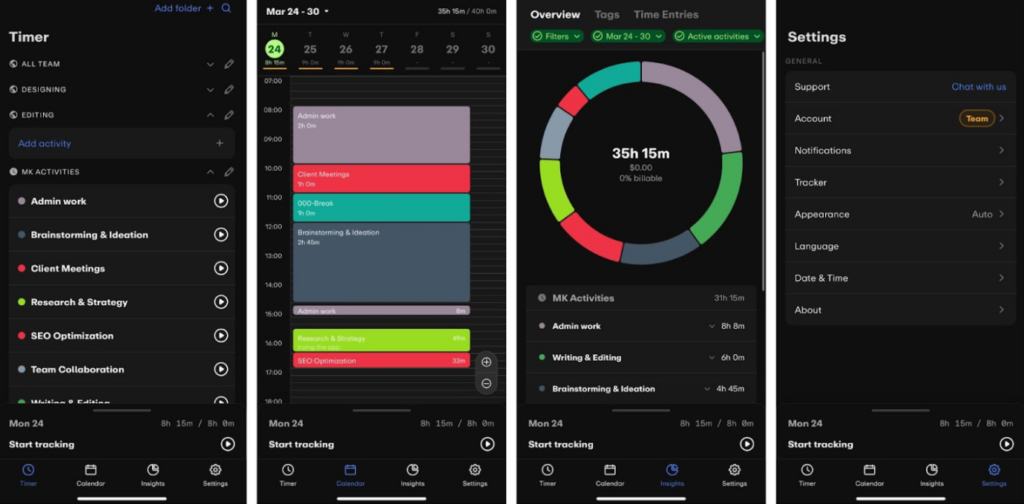
EARLY’s mobile app feels like a simplified companion to the desktop version. You can start and stop tracking, view past entries, and log time manually. The design is clean and responsive, making it easy to capture time on the go. I liked how quickly I could add missed entries without needing to open my laptop.
However, the functionality is noticeably limited compared with the desktop version. There’s no multi-column calendar view, and editing entries lacks the drag-and-drop ease you get on a larger screen. Also, there are no automatic time tracking and time off tracking options in the mobile app.
Another major limitation I ran into: While offline tracking works on the desktop, it doesn’t work on mobile. If you’re without internet—even briefly—you can’t track time at all, which can be a deal-breaker for field workers, travelers, or anyone in areas with spotty coverage. It felt like a missed opportunity, especially when many competitors offer full offline logging across all devices.
Verdict: 7/10
| Feature / Menu Item | Admin | Employee | ||
| Desktop app | Mobile app | Desktop app | Mobile app | |
| Core features | ||||
| Calendar (Time Tracking View) | ✅ | ✅ | ✅ | ✅ |
| Manual Time Entry | ✅ | ✅ | ✅ | ✅ |
| Automatic Tracking (AI Suggestions) | ✅ | ❌ | ✅ | ❌ |
| Quicktrack | ✅ | ❌ | ✅ | ❌ |
| Offline Tracking | ✅ | ❌ | ✅ | ❌ |
| Leave, break, overtime logging | ✅ | ✅ | ✅ | ✅ |
| Analysis | ||||
| Insights / Analytics Dashboard | ✅ | Limited | ✅ | Limited |
| Billable vs Non-Billable Reports | ✅ | ❌ | ✅ | ❌ |
| Management | ||||
| Team Reminders | ✅ | ✅ | ✅ | ✅ |
| Project & Folder Setup | ✅ | ✅ | ❌ | ❌ |
| Budget Management | ✅ | ❌ | ❌ | ❌ |
| Team Roles & Permissions | ✅ | ✅ | ❌ | ❌ |
| Time Entry Approvals | ❌ | ❌ | ❌ | ❌ |
Note: This table compares desktop and mobile apps’ features. Please note that there’s also a browser version, and some features (e.g., automatic tracking) aren’t available in that version.
EARLY Core Functionalities
Time tracking
EARLY gives you multiple ways to track time across desktop, web, and mobile. Whether you’re logging time live, filling it in later, or letting the app track automatically, it adapts to your workflow.
The core interface is a clean visual calendar where manual entries, breaks, time off, and events appear side by side.
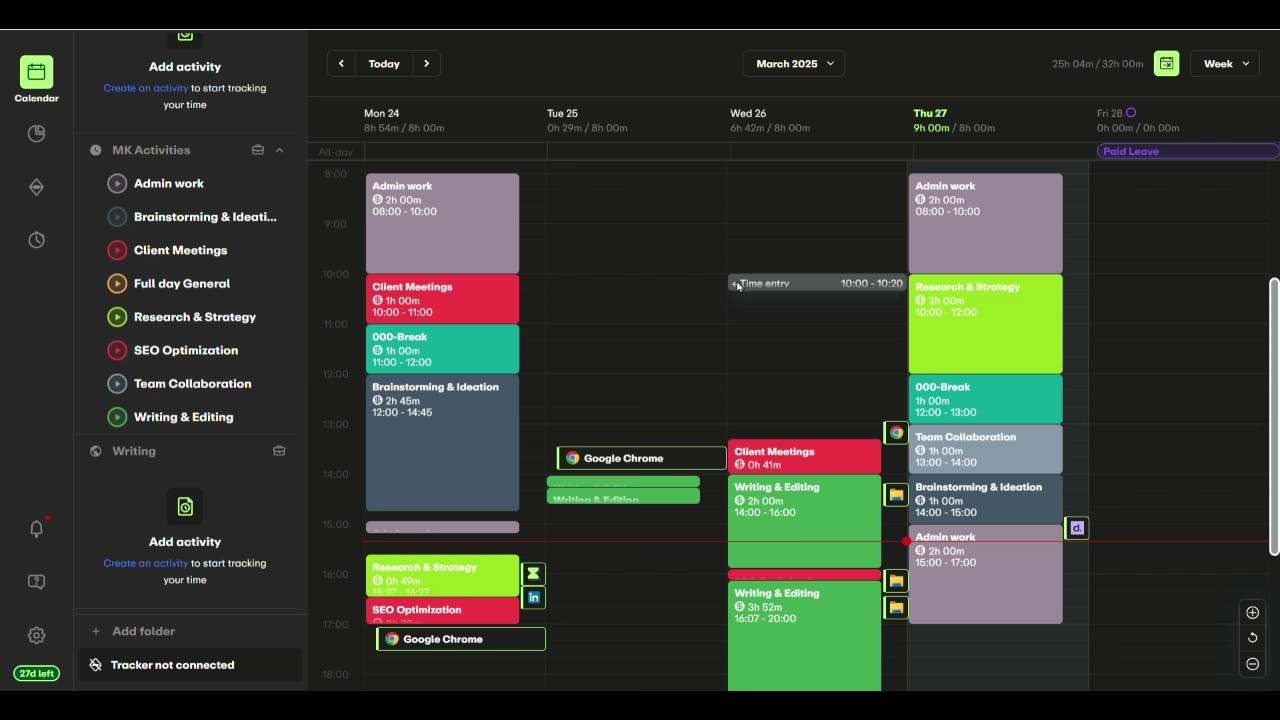
At first glance, I thought the Calendar tab might support shift scheduling or task planning like other tools, but it can’t. You can review where your time went—by activity or project—but you can’t assign shifts or plan hour-by-hour team workloads (though you can set working days and hours—e.g., 6 hours on Wednesday).
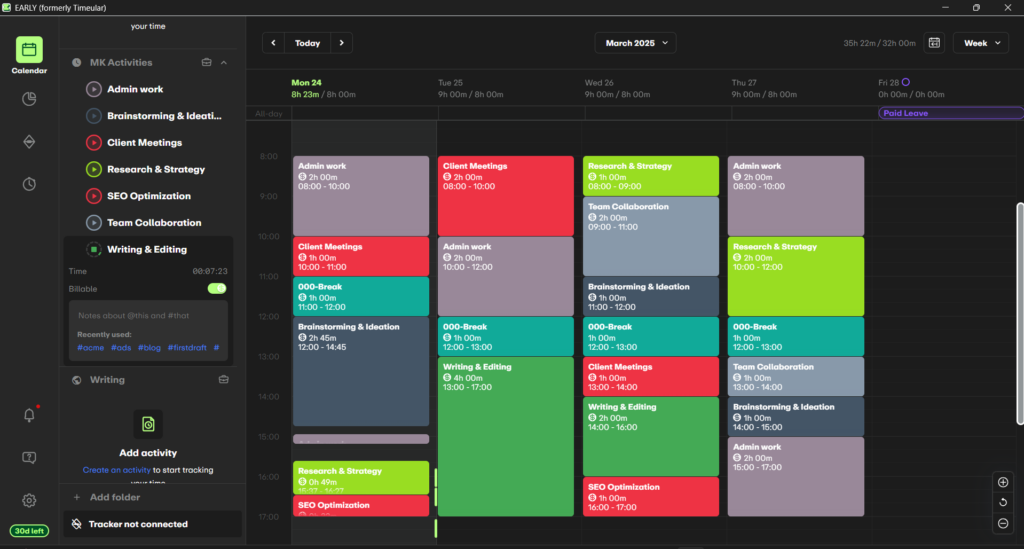
You can add manual time entries by dragging your cursor directly on the calendar, as I do in the video above. You can easily create new time blocks or adjust existing ones.
Automatic tracking is where EARLY stands out. Its AI monitors app and website activity and suggests time blocks, which are flagged with a lightning icon. You can approve, tweak, or discard them. It often guesses your work accurately using your calendar and apps. It’s not flawless, but it’s impressively smart—and it gets better with use.

Quicktrack is a handy pop-up shortcut that lets you log time instantly from anywhere without opening the full app or switching whatever you’re working on.
You can also track time off, breaks, and overtime. These are created manually, with no automatic rule implementation—something apps like Connecteam have. For instance, Connecteam lets you create rules to automatically apply overtime pay for overtime hours, while EARLY doesn’t. EARLY relies on self-reporting or admin checks—which could lead to compliance issues.
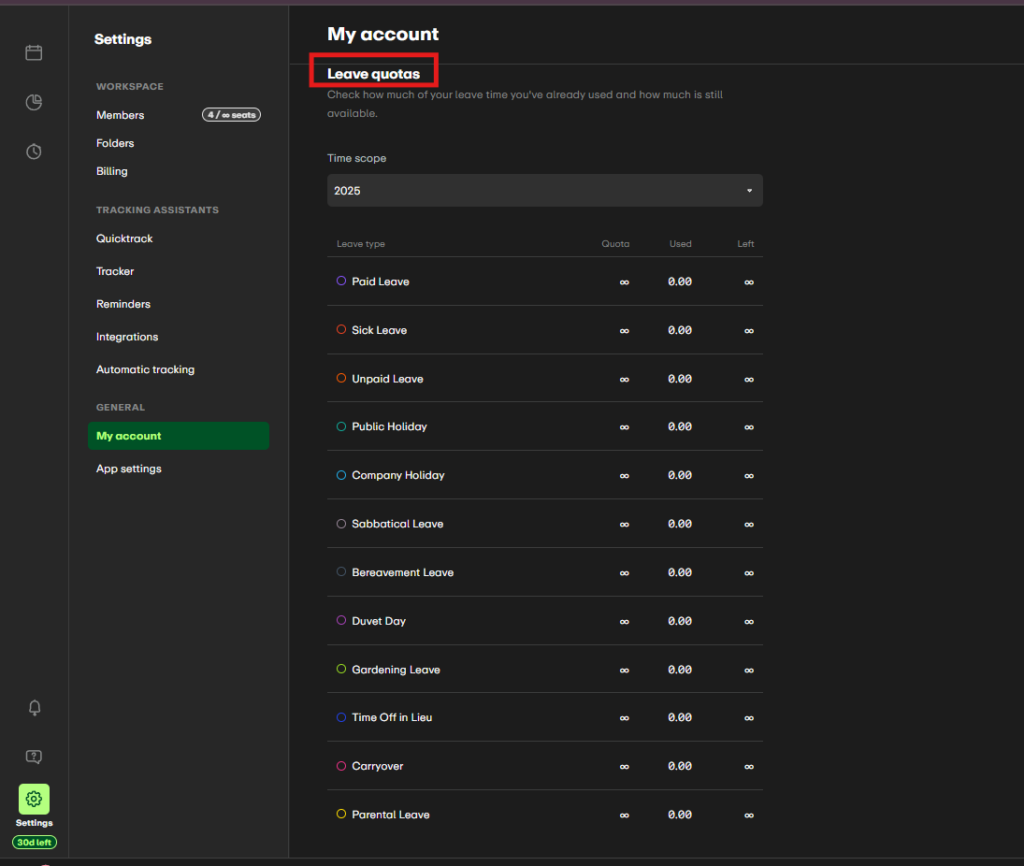
EARLY’s overtime tracker shows how much someone has exceeded their pre-set work hours. It calculates “over” or “under” hours automatically, flags them, and lets workspace admins compensate workers with time off, payouts, or carryovers.
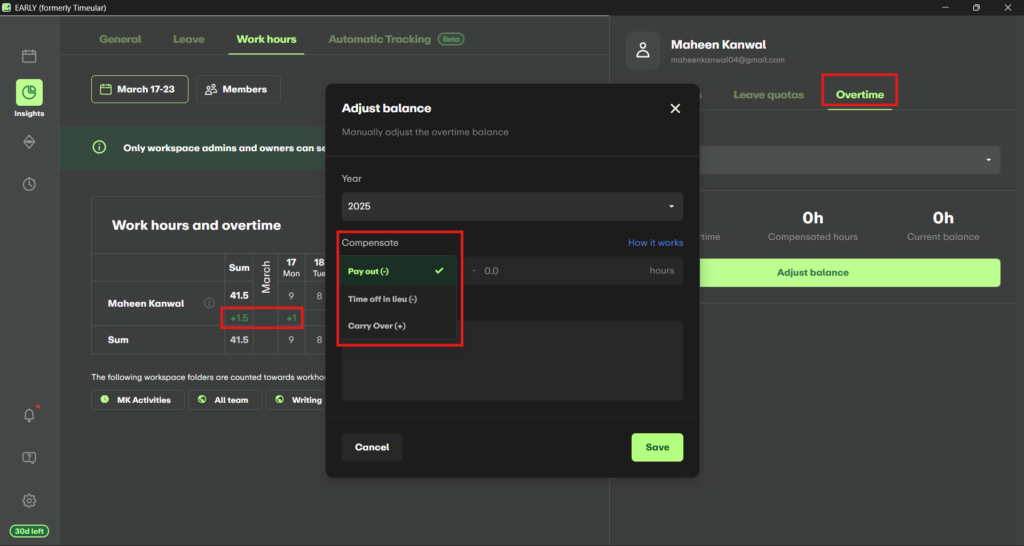
Offline tracking works well on web or desktop apps—you can log time without internet, and data syncs once you’re back online. Conflicting time entries are flagged right away, so no overlap slips through unnoticed.
Where EARLY falls short is in location control and compliance. There’s no GPS tracking or geofencing for ensuring workers are at the correct job sites when tracking time. You can’t prevent early punches or skipped shifts, and you can’t enforce break rules. This makes it unsuitable for field teams or businesses needing tight timekeeping policies.
See Connecteam’s GPS Tracking in Action
Request a Free DemoVerdict: 7/10
Project management
EARLY gives you just enough structure to organize tracked time without becoming a full project management tool. You can create folders for clients or departments, add activities to them, and tag entries using hashtags or mentions like #clientA or @design. It’s flexible and lets you build your own system—ideal whether you’re billing, managing a team, or just staying organized.
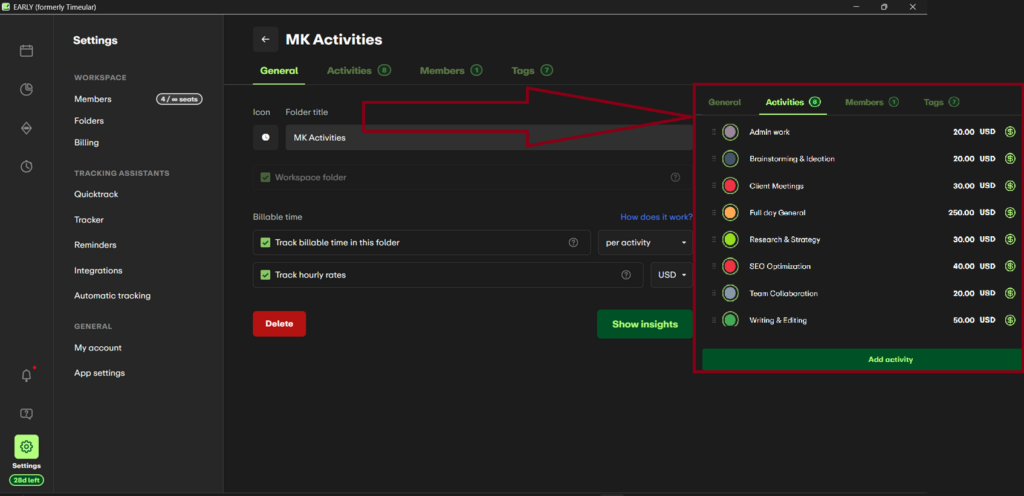
You can mark entries as billable or non-billable and assign hourly rates per user or activity. EARLY’s billable tracker automatically calculates earned revenue, and I found this feature handy for invoicing. The calendar shows rate tags, and totals roll up neatly in the Insights tab—no spreadsheets needed.
The budgeting tool lets you set time limits per project and get alerts when you’re nearing them. It’s a great safeguard for fixed-scope work. Pro and Team plans allow up to 50 budgets, and budgets can be shared with team members or kept private.
While this is great for basic project management, there are no task dependencies, Kanban views, Gantt charts, or workflow tools. There’s also no commenting, file sharing, or centralized to-do lists. It’s a time-first system, not a task management platform.
Still, I liked how folders, tags, and billable flags helped me spot trends—like how much time went to client work vs. admin. It keeps reporting clear and focused.

Verdict: 8.5/10
Physical tracker
EARLY offers an optional 8-sided physical time tracker that lets you switch tasks by simply flipping the physical tracker. Each side can represent a different activity or project, and when paired with your desktop (macOS or Windows), it logs time based on the side facing up—no clicks or app launching required.
Setup is straightforward: Pair the device, assign sides in the companion app, and optionally label them with the included stickers. It’s a tactile, screen-free way to shift focus. For those who tend to forget timers or get distracted by screens, I can see how this tool could create a more mindful workflow.
But it’s not without issues. Some users have reported flaky Bluetooth connections, and others have said the tracker often stops. The tracker doesn’t work on mobile, has no display or vibration feedback, and can’t auto-pause if you walk away—so you’ll need to rely on the app to verify tracking.
It’s desk-bound and best for users who stay in one place. Although I couldn’t test it, I think it sounds like a nice add-on. But if you’re already comfortable with keyboard shortcuts or Quicktrack, it’s not necessary.
Verdict: 8/10
Integrations & API access
EARLY offers a small, focused set of integrations aimed at improving time tracking—but not full operations. The calendar sync with Google Calendar, Outlook, or iCal is genuinely helpful—your scheduled events show up in your calendar view and can be converted into time entries with 1 click.
Beyond that, the only direct integrations currently supported are Toggl, JIRA, Harvest, and Zapier. These are available only on the Personal Pro or Team plans, which felt restrictive—I couldn’t test them on the Personal tier.
There’s also an open API for custom connections.
Unfortunately, there aren’t direct integrations with payroll, accounting, GPS, shift scheduling, or HR tools. That makes it feel incomplete for businesses needing end-to-end workflows.
Verdict: 5/10
EARLY Reporting & Analytics
EARLY gives you a dedicated Insights tab where all your tracked data is broken down into visual reports. You can filter by day, week, month, project, team member, or folder. The dashboard is clean and intentionally focused—it doesn’t overwhelm you with data, but it still gives you enough information to help you spot patterns, monitor productivity, and make smarter time-based decisions.
Here are some reports you’ll find:
- Time Overview: A timeline of total hours worked, split by day or week. It’s great for spotting over-hour or under-hours periods.
- Activity Breakdown: Pie or bar charts showing time spent by activity, folder, or project.
- Billable vs. Non-Billable: Highlights how much of your time is revenue-generated vs. internal or unbilled.
- Overtime Summary: Shows how much time exceeded your set work hours per week or day.
- Time Off Reports: Displays leave days and breaks, plus how they’re distributed across time.
- Team Reports (Team/Enterprise only): Aggregates how your team spends time, sorted by person or project.
Generating reports in EARLY is refreshingly simple. There’s no need to build dashboards or tweak settings—just select a timeframe, project, or user, and visual insights load instantly. Exporting to CSV or PDF is quick and reliable: I used it for invoicing and retrospectives without issues.
For individuals and small teams, customization is solid. You can filter by user, project, folder, tags, or date. But advanced features like custom KPIs, recurring reports, or scheduled exports aren’t available. There’s also no multi-metric dashboard or BI integration.
If you need deep reporting, cross-team comparisons, or integrations with tools like Power BI or Tableau, EARLY won’t deliver. Its reporting is geared more toward offering insights into individual and team behaviors than into business operations.
Verdict: 8/10
EARLY Security
EARLY is built with a strong privacy-first approach. All time entries and user data are end-to-end encrypted and hosted on secure EU-based servers, ensuring GDPR compliance. If you’re handling sensitive client data, that’s a reassuring baseline.
You can enable 2-factor authentication, and all communication is encrypted via HTTPS. The platform clearly states it doesn’t sell or share user data, and its privacy policy is transparent and easy to follow.
Admins can control workspace visibility—hiding folders, entries, or reports as needed. But there’s no audit trail or activity log, which may be limiting for larger teams needing accountability.
I didn’t find evidence of SOC 2 or ISO 27001 certification or HIPAA or DPA-level controls, so highly regulated industries may need to seek clarification before onboarding.
Verdict: 8/10
EARLY Customer Support
EARLY offers support mainly through a live chat, an in-app chat widget, and an extensive online help center. The help center is well-organized, with clear articles on setup, tracking, and integrations. I found it easy to navigate and helpful for most how-to queries.
However, my experience with live support was mixed. I reached out with simple questions 2 separate times on different weekdays and at different times, and each time, I was met with an automated bot asking for my email so a team member could follow up.
I did finally get a reply—after about a day. The rep said they’d check internally and get back to me, but I never heard back after that. For a tool aimed at professionals, this kind of lag makes support feel like an afterthought.
There’s no live support on weekends, no phone line, and no user community for peer answers. While the product is stable enough that you likely won’t need help often, when you do, don’t expect fast or responsive support.
Verdict: 6/10
What are EARLY’s Review Ratings from Review Sites?
(As of April 2025)
Capterra: 4.6/5
G2: 4.6/5
Software Advice: 4.6/5
TrustRadius: 9/10
GetApp: 4.6/5
Google Play Store: 3.7/5
Apple App Store: 4.5/5
EARLY App Review
EARLY is a smart, minimal time-tracking tool that works best for individuals and small teams focused on productivity and reflection. I loved how effortless tracking felt, especially with its AI suggestions and clean interface.
But it lacks essential operational features like GPS tracking, shift scheduling, and compliance controls—making it unsuitable for field teams or larger workforces.
If you’re looking for some insight, not full oversight, EARLY delivers. Just don’t expect it to help you manage teams or enforce structure.
Connecteam: The Better EARLY Alternative
If you’re looking to manage not just time but also people, tasks, and operations, Connecteam is the best alternative to EARLY.
Both platforms offer manual time tracking, mobile apps, overtime logs, project tagging, and activity insights, but Connecteam takes it further with a 1-click employee time clock, GPS tracking, geofencing, overtime tracking, and break enforcement—making it a compliance-ready attendance system.
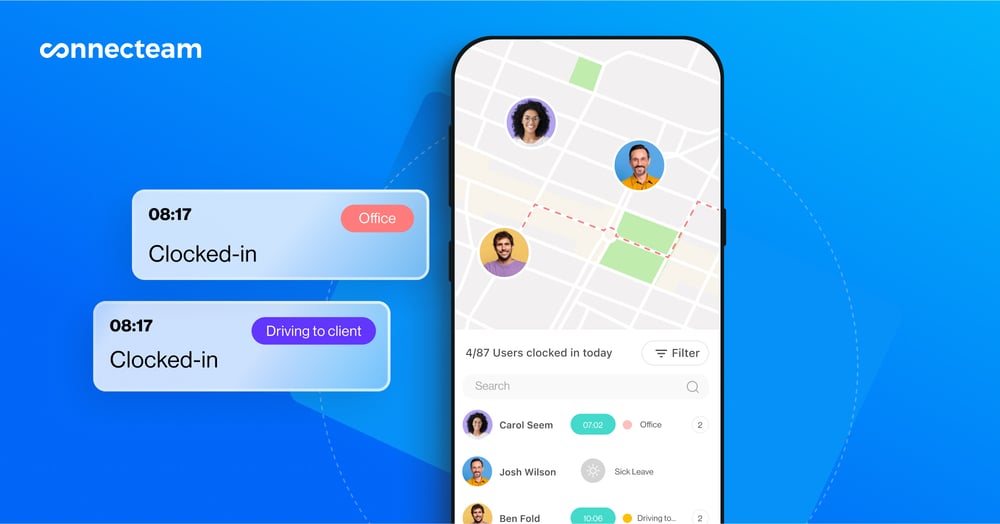
Connecteam also supports employee task tracking, letting you assign tasks, due dates, subtasks, and automated reminders. Employees can clock into specific tasks, while managers track progress in real time. This level of accountability tied to deliverables is ideal for team-driven workflows.
For scheduling, Connecteam makes things simple with drag-and-drop shift planning, templates, real-time notifications, and conflict alerts. Whether you’re managing a single team or rotating shifts across multiple sites, it handles the heavy lifting.
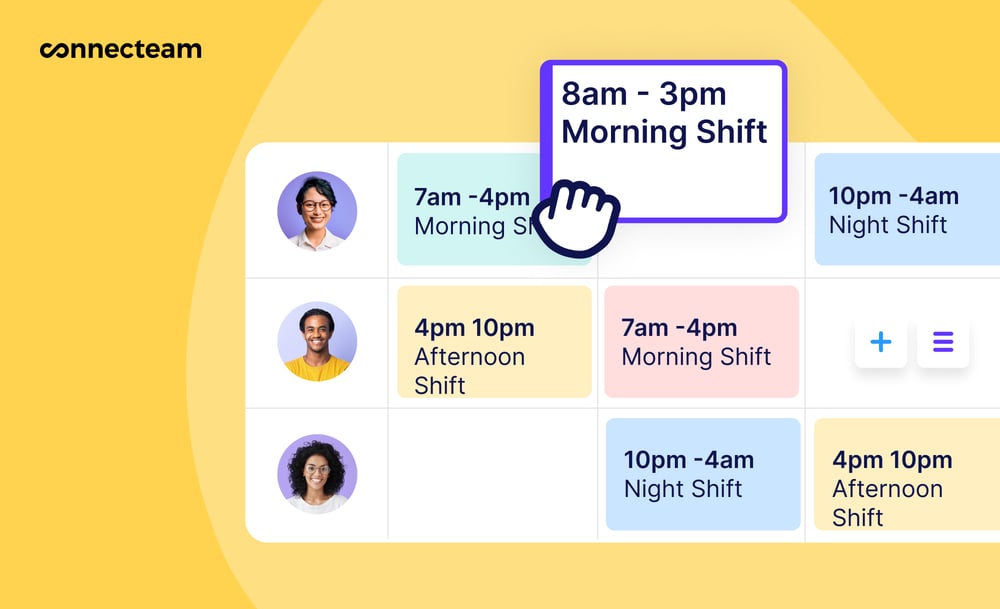
Connecteam also includes a timesheet management system for all your payroll and admin needs. Hours—along with breaks, overtime, and time off—are automatically organized and exportable with 1 click to payroll and accounting providers like QuickBooks, ADP, or Gusto.
Beyond time tracking, Connecteam offers a full operational toolkit, including:
- Built-in online team chat, updates, and employee directory
- Leave requests with approval workflows and policy enforcement
- Training and knowledge base modules for onboarding and compliance
- Digital forms and workflows to handle reports, incidents, or approvals
- Kiosk mode for shared-device clock-ins
If EARLY is built for individuals, Connecteam is built for teams—especially when you need to manage time, people, and compliance in one simple platform.
👉 Try Connecteam for free and see the difference.
FAQs
EARLY offers a 30-day free trial for all paid plans. You get full accaess to features like AI tracking, calendar sync, and team tools—no credit card required.
EARLY isn’t advertised as being HIPAA-compliant. It might not offer the administrative, technical, or contractual safeguards required for handling protected health information (PHI) in the US.
